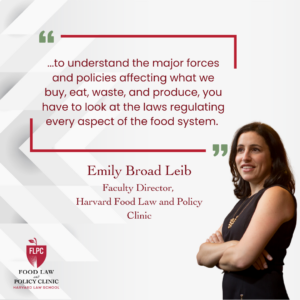The Food Law and Policy Clinic at Harvard Law School, partnering with the Johns Hopkins Center for a Livable Future, has released an update to the toolkit Good Laws, Good Food: Putting Local Food Policy to Work for Our Communities. The toolkit is designed to aid individuals and groups, including local food advocates and nonprofit organizations such as local food policy councils, working to change their local food system. This toolkit was created to provide a starting place for these individuals and groups to understand basic legal concepts surrounding local food systems, develop a base of knowledge about the main policy areas, and be inspired by innovative policy solutions from other cities and states.
A growing number of local food advocates have become concerned about the impacts of the current food system on our health, our environment, our national and local economies. These advocates are discouraged by the system’s environmentally damaging practices, inequitable distribution of healthy foods, and lack of opportunity for civic engagement in the current model of food production and consumption. Recognizing these issues, many advocates have attempted to search for methods to reverse them with healthy, environmentally sustainable, and economically and socially just food policies.
However, local food advocates can find it difficult to identify the specific laws and regulations that impact their food policy goals, analyze these laws and policies, and ascertain the legal or policy levers that can be used to improve outcomes. Good Laws, Good Food: Putting Local Food Policy to Work for Our Communities (2nd ed.) was created to enable food advocates to overcome these challenges. This updated second edition accounts for some of the changes that occurred in food policy over the past five years and adds new sections on food waste and food procurement, and updates other sections such as school food and nutrition education. The toolkit is composed of eight sections that cover a range of potential topics that a local food policy council or advocate may wish to explore.
Section one, General Legal Setting, lays out some of the basic information relevant to the local government’s authority to makes laws. This section gives an overview of the types of food law and policy regulations that can be implemented at the local level, as well as some local government agencies with which councils should partner.
Section two, Food System Infrastructure, describes the important roles of all the entities and processes that make up a local food system. This section details policies that encourage and support local food-related business at every step of the supply chain, including production, processing, distribution, retail sales, marketing, and waste management. The third section, Land Use Planning and Regulation, gives a broad overview of zoning and land use concepts to offer local food policy councils an understanding of the state and local laws surrounding land use. A familiarity with the laws that govern land use can be beneficial for advocates who want to improve the existing legal scheme to further their goals. Section four, Urban Agriculture, describes a variety of ways local food policy councils can work with local governmental or non-governmental partners to support existing or potential urban agriculture initiatives. This section includes information concerning zoning and resource allocation for urban agriculture, as well as addressing environmental concerns such as converting former brownfields to land that is suitable for urban agriculture. The fifth section, Consumer Access & Consumer Demand, presents an introduction to the policy changes that can help connect communities with more outlets to purchase healthy foods. This section describes a variety of different solutions to increase food access, including farmers markets, community-supported agriculture (CSAs), mobile vending, retail establishments, healthy corner stores, and community gardens.
A new section in this updated toolkit is section six, Procurement. The section describes potential measures food policy councils can pursue to adopt procurement policies that favor local and regional producers, as well as fair labor practices, environmentally-sustainable production methods, and humane treatment of animals. Section seven, School Food and Nutrition Education, has been heavily updated. It details the ways in which local food policy councils can work with local agencies and school districts to improve the quality of the food served in school meals, and create or enhance nutrition education programs. This section also explores programs such as farm to school initiatives and school and community gardens that connect students to the topics of food and agriculture. The final section, which is another addition to the updated toolkit, is section eight, Decreasing and Recovering Wasted Food. It describes how food is wasted all along the supply chain and provides steps that advocated can take to minimize wasted food at all levels of the food chain.
The toolkit is a valuable guide for advocates who seek to influence food law and policy in their local communities. It is part of a growing collection of resources created by the Food Law and Policy Clinic at Harvard Law School to assist and support local policy advocates. The toolkit will also be followed by a public webinar on October 26 at 1 p.m. E.T. during which the Food Law and Policy Clinic will provide an overview of the toolkit and will answer questions from participants. To participate in the webinar, please register.
Read Good Laws, Good Food: Putting Local Food Policy to Work for Our Communities.


Health Law & Policy, Commentary
Braidwood Management v. Becerra: Updated FAQs for Health Advocates and Providers
July 22, 2024